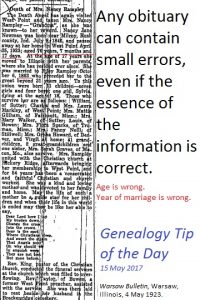Even if the essence of a document is true, it can still contain errors. Just because an item seems to have every detail correct,
there may still be factual or typographical errors. This 1932 obituary contains two minor errors–the age at death and the year of the marriage. The date of birth is consistent with other records (there is no birth record or family bible entry for her birth) and the date of death agrees with the death certificate.
Don’t assume that everything is right just because 90% of it is.
At least they used her name and didn’t just call her “Grandma.”







5 Responses
While I understand some mistakes r noticeable, and easy to spot. How do u know what the other mistakes might be? Is it because u already knew the mistakes or does it not seem practical 4 that information to be there? Maybe the information couldn’t possibly be correct at that time?
Looking at all the records you can find is a good start. Always transcribe things exactly as they appear is another thing to keep in mind. One can always make annotations indicating what is “wrong” compared with other records or what looks like it might be incorrect.
I never look at a Newspaper, Book or News journals as a primary document. I view them only as a Secondary sources. Therefore before I accept them as proof for any research I’m working on, I seek at least 2 additional secondary sources. I look at documents as information only being obtained from a Primary source. In my many years of researching I have found too many errors in Newspapers. journals, books and other material. I also feel the same about Census records since one never knows who supplied the information. In other words I use them but only with caution. Also cemetery grave stones are not acceptable in some Lineage organizations.
Trying to get as many sources as possible is always good. Print sources can easily range from accurate to riddled with errors, depending upon the informant. Even sources that agree in content but were created decades apart can have the same informant.
This person may not have been called Grandma, could have been just Mrs ….. I found one that turned out to be a relative…she was listed as Mrs…… would never have found if I hadn’t looked.